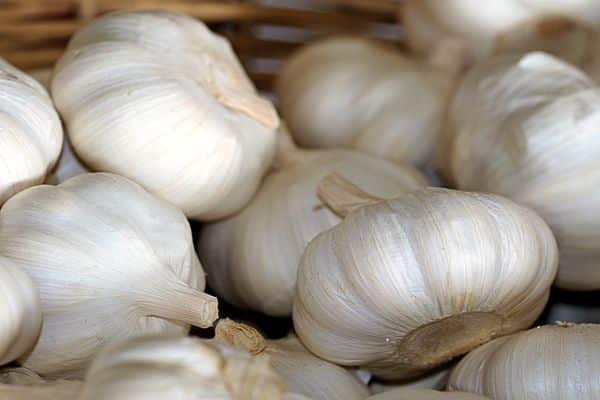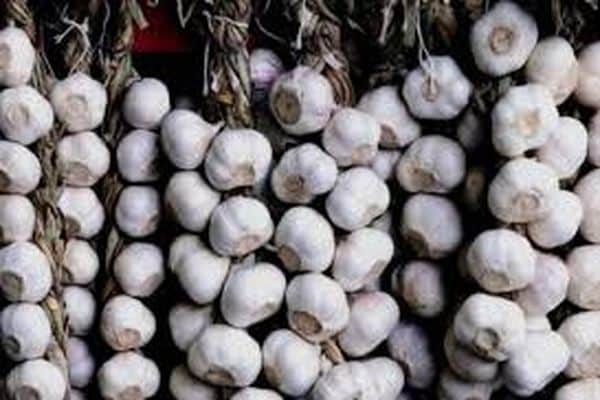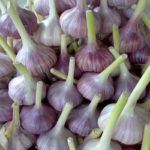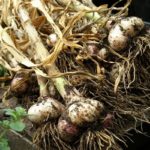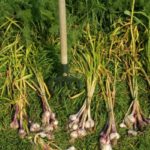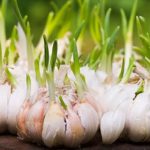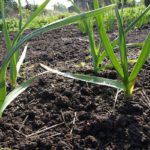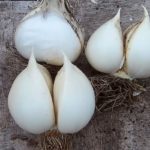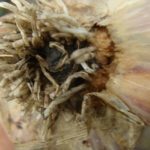The shooting variety of garlic Reliable (Winter) has a universal purpose. The name of the variety accurately reflects its characteristics. The root vegetable is ideal for use in preparing various dishes and for preservation.
Description of the variety
The winter variety is distinguished by its large leaves, in comparison with similar root crops. The leaves of the plant reach a length of over 1 m and a width of up to 2 cm. The color of the leaves is green with a slight waxy coating on the surface, the color of the outer cover is dusty white with a rich shade of purple.The root crop is a mid-season one; the period from sprouting to full lodging of leaves is 100–120 days.
Garlic heads are round-flat, their weight varies between 55–70 g. Each head contains 5–7 white cloves of an aligned shape with rounded shapes. The weight of one clove can reach 11 g. The winter variety is distinguished by juicy pulp and a richly pungent taste. When planted on a summer cottage, the yield is 1–1.5 kg per square meter. m.
Growing
Seeds need to be planted in pre-formed beds. A month before sowing, the soil is dug up, treated with organic fertilizers and loosened. The decisive factor in choosing the time to plant is the weather forecast for the next few weeks.
Before the onset of stable frosts, the root crop must have time to form a powerful root system, which will ensure resistance to cold climates.
As the description of the variety indicates, its weight may vary, and the correct approach to growing and sowing has a direct impact on this factor. The root crop can be planted either by seeds or propagated by cloves or bulbs.
Regardless of the planting method, roots will begin to grow only when the appropriate temperature and moisture level are provided.
Features of care
Not recommended grow garlic in one place for several years, since over time the soil is depleted and pests harmful to the crop accumulate in it. Even the use of fertilizers cannot completely clean the soil. The improvement of the variety is facilitated by the use of ripe aerial bulbs when planting. After a season, planting large monotooths will produce full-fledged juicy fruit heads.
Planting beds should be selected with fertile soil, good lighting and without stagnant water. Greenhouse conditions are excellent for Winter garlic, promoting a stable harvest. The main measures for caring for seedlings include:
- Regular watering once every 5 days.
- Loosening the earth.
- Weeding the land with constant removal of weeds.
- At least two feedings during the growing season.
- Elimination of arrows in the summer, when their length reaches 12 cm.
Garlic of the Reliable variety negatively tolerates thickened plantings, so there should be a distance of about 25 cm between the rows, and more than 10 cm between the bulbs.
To insulate the beds for the winter and supply additional nutritional components, only organic materials should be used to cultivate the land.
Green shoots begin to sprout a couple of weeks after the first warming (late March - early April). Depending on how large the leaf apparatus is formed in the spring, the larger the head will be. This feature allows you to predict the yield in advance.
Advantages and disadvantages
The main disadvantage of the Reliable garlic variety is the need to comply with a number of conditions when planting. Nevertheless, a competent approach to sowing and growing provides the following advantages:
- Good keeping quality. Dried heads, if properly stored and maintained at a temperature of about 20 degrees, can be stored for a year.
- Pest resistance. Timely treatment of plants with fertilizers helps protect the crop from loss.
- Large heads. Compared to many other varieties, Nadezhny garlic produces a larger harvest.
- Taste qualities.The winter variety has aromatic and piquant characteristics, which allows for greater variability in consumption and use in cooking.
- Frost resistance. With periodic rainfall and frost, garlic does not lose its beneficial characteristics and can provide a good harvest.
The listed characteristics make the Ozimy variety ideal for growing on small farms, in household plots and cottages. Garlic produces the best yield results in mid-latitude areas.
Pests and diseases
In terms of damage, the most dangerous pest of garlic is the stem nematode. This is a white worm, up to 1.5 mm long, feeding on plant sap. If the root crop is damaged by the larvae, growth slows down, the roots dry out and cracks appear on the outside of the heads. After one plant dies, the worms move through the soil to the next.
To eliminate these pests, you need to add a mixture of coarse sand and peat to the soil. As an additional remedy, it is useful to treat the soil with a solution of table salt.
Common onion mites and flies can also have a negative impact on garlic varieties. These pests are less dangerous, but their timely elimination will contribute to good and stable growth of the crop. In order to eliminate pests and prevent diseases of root crops, compost infusion, ash solution and a mixture of water and ammonium nitrate should be used.
Harvest and storage
At the ripening stage, avid gardeners advise raking the soil from the heads to their middle. This method helps speed up the process of root formation and make it larger and richer in taste.17–25 days before harvesting, it is necessary to completely stop watering. Garlic should be harvested in July. The main sign indicating the ripening of the root crop is the appearance of cracks in the shell of the aerial bulbs and significant yellowing of the lower leaves.
If it is necessary to store garlic, it is important to ensure protection from moisture evaporation, even temperature and pre-drying.
You can store the harvest in several ways:
- in the refrigerator in a plastic bag, if the temperature is maintained from -3 to 10 degrees;
- in a box or box, laying the root vegetables on top of each other in 2-3 layers;
- in cling film at room temperature;
- in a net, hanging it in cool storage.
Reviews from gardeners
Alena, 29 years old: “I usually plant several different varieties of garlic at once. This time Winter yielded better yields. There were few pests, fertilizers helped to easily correct the situation.”
Marina, 41 years old: “I came across this garlic variety for the first time. There were no difficulties in growing, the harvest is very prolific. I’ve been storing it in the refrigerator at home for five months now and periodically using it in cooking—the taste gets even better over time.”


